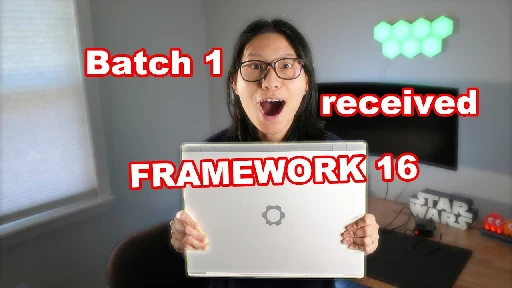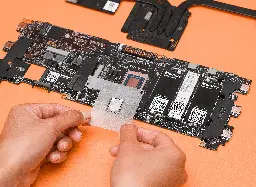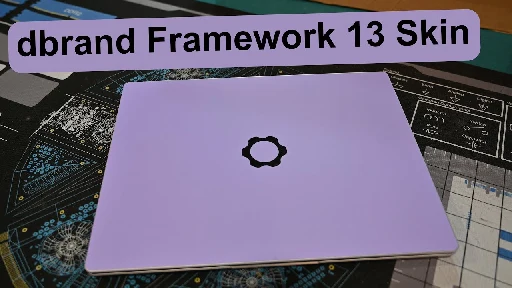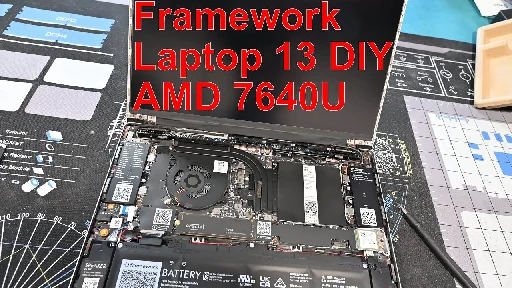
YouTube Video
Click to view this content.
Choose from AMD and Intel system options, select your preferred memory and storage, operating system, and more customizations. Available in DIY and pre-built configurations.

On their order page, it says "Ships within two weeks"
Cheers!
In this Deep Dive, we're providing detail on the liquid metal thermal interface we’re using to maximize CPU performance.


YouTube Video
Click to view this content.

YouTube Video
Click to view this content.
https://iso.pop-os.org/22.04/amd64/intel/33/pop-os_22.04_amd64_intel_33.iso
https://iso.pop-os.org/22.04/amd64/intel/33/SHA256SUMS
>Ever thought, "Why should I care about online privacy? I have nothing to hide." Read this https://www.socialcooling.com/
credit: [deleted] user on Reddit.
original link: https://old.reddit.com/r/privacy/comments/savz9u/i_have_nothing_to_hide_why_should_i_care_about/
>
> u/magicmulder
>The main issue isn’t that someone would be interested in you personally but that data mining may put you in categories you don’t want to be in. 99.9% correlation of your „likes“ and follows to those of terror suspects - whoops you’re a terror suspect yourself. You follow heavy metal bands and Harley Davidson? Whoops, you have a 98% likelihood of drinking and smoking, up goes your insurance rate. And so on.
>
> u/Mayayana
>Indeed. But most people here seem to have misunderstood your post. One of my favorite examples is from Eric Schmidt, chairman of Google, whoo said in an interview (on youtube) that if you think you have something to hide then maybe you shouldn't be doing what you're doing. (Like maybe the Jews on Kristallnacht shouldn't have been living in their houses?) Schmidt was later reported to have got an apartment in NYC without a doorman, to avoid gossip about his promiscuous lifestyle. :)
>
> u/SandboxedCapybara
>I always thought the like "no bathroom door," "no curtains," or "no free speech" arguments always fell flat when talking about privacy. Sure, as people who already care about privacy they make sense, but for people who don't they are just such hollow arguments. I think a better argument is real life issues that people always face. The fact that things like their home address, social security number, face, email, phone number, passwords, their emails and texts, etc could be out there for anyone to see soon or may already be is almost always more concerning for people. People trust companies. People don't trust people.
>
> u/Striking-Implement52
>Another good read: https://thenewoil.org/why.html 'I've Got Nothing to Hide' and Other Misunderstandings of Privacy
> etc
>Even after all these years firefox keeps using mozilla hidden directory instead of XDG base directories. For how long will this continue?
>Watch https://bugzilla.mozilla.org/show_bug.cgi?id=259356 for updates to this request.
>~/.mozilla/firefox/<profile> is a mish-mash of data, config, and cache. It's not simple to unravel that. Beyond that, it would be a breaking change, and that requires more caution.
>
>
credit: u/yo_99 on Reddit.
original link: https://old.reddit.com/r/firefox/comments/vkgk78/why_does_firefox_keeps_using_mozilla_directory/
There are two main aspects to coreboot in my opinion that differentiate it from other firmware ecosystems:
The first is a strong push towards having a single code base for lots of boards (and, these days, architectures). Historically, most firmware is build in a model I like to call "copy&adapt": The producer of a device picks the closest reference code (probably a board support package), adapts it to work with their device, builds the binary and puts it on the device, then moves to the next device.
Maintenance is hard in such a setup: If you find a bug in common code you'll have to backport the fix to all these copies of the source code, hope it doesn't break anything else, and build all these different trees. Building a 5 year old coreboot tree on a modern OS is quite the exercise, but many firmware projects are near impossible to build under such circumstances.
With coreboot, we encourage developers to push their changes to the common tree. We maintain it there, but we also expect the device owner (either the original developer or some interested user) in helping with that, at least with testing but more ideally with code contributions to keep it up to current standards of the surrounding code. A somewhat maintained board is typically brought up to latest standards in less than a day if a new build is required, and that means that everybody has an easy time to do a new build when necessary.
The second aspect is our separation of responsibilities: Where BIOS mandates the OS-facing APIs and not much else (with lots of deviation in how that standard is implemented), UEFI (and other projects like u-boot) tends to go the other extreme: with UEFI you buy into everything from build system, boot drivers, OS APIs and user interface. If you need something that only provides 10% of UEFI you'll be having a hard time.
With coreboot we split responsibilities between 2 parts: coreboot does the hardware initialization (and comes with its build system for the coreboot part, and drivers, but barely any OS APIs and no user interface). The payload is responsible for providing interfaces to the OS and user (and we can use Tianocore to provide a UEFI experience on top of coreboot's initialization, or seabios, grub2, u-boot, Linux, or any program you build for the purpose of running as payload).
The interface between coreboot and the payload is pretty minimal: the payload's entry point is well-defined, and there's a data table in memory that describes certain system properties. In particular the interface defines no code to call into (including: no drivers), which we found complicates things and paints the firmware architecture into a corner.
To help payload developers, coreboot also provides libpayload, a set of minimal libraries implementing libc, ncurses and various other things we found useful, plus standard drivers. It's up to each coreboot user/vendor if they want to use that or rather go for whatever else they want.
credit: [deleted] user on Reddit.
> Hi everyone, I have just recently found out there is a thing like coreboot/libreboot, and I like the concept of it: fast(er), secure, open source, easy to flash and non-brickable process.
> I’ve been trying to understand the basics behind it and it’s too difficult for me. I have some basic understanding of what BIOS / EFI is. And as I understand it, the core/libreboot is an open-source replacement for it. Great!
> But what I’m interested in is understanding, how it manages to be better than the OEM’s BIOS? I understand that the nature of open-source is better than closed source software, but what I don’t understand is how this project manages to be better for end-user?
> As I get it, it’s similar to Custom ROMs on Android. There is an OEM’s rom — say, Samsung — it makes its version of Android, and it’s good (in terms of how it works with the hardware), but usually with tons of bloatware and OEM never updates the phone after a customer bought it. Here we have Custom ROMs, like CyanogenMod / Lineage OS / Pixel Experience / etc. etc. Those ROMs somehow manage to keep the software updated for much longer time-frame, having extra functionality and even working faster. (Frankly, I don’t understand how do they manage to do that as well, and why it’s so difficult for OEMs.)
> Is this something similar? I can understand the (ineffective) processes of big corporations, but I cannot understand how the developers manage to keep those things better, lighter, etc. Say, whether the OEM’s firmwares somehow bloated? Why is so then? Why won’t a big company like Gigabyte, Asus, Acer, etc. also use this product, why do they write so-closed-source BIOSes and EFIs then, if they can use something lighter and faster, and in so many ways better? As it’s advertised on the website of coreboot.
> I’m not sure I keep the question simple, for others to understand, but if talking about the real hardware. Say, I have Asus MAXIMUS IV GENE-Z motherboard. Can I install coreboot on it (seems like yes, according to the website https://coreboot.org/status/board-status.html#asus/maximus_iv_gene-z), and if I can, will it miss some functionality comparing to its original EFI? I mean not that I need it, but I’m interested whether there’s something special in original firmware or not. There are many things on the website, at ‘ROG Exclusive Features’ and ‘Special Features’ sections, but I’m not aware if it’s something special or it’s just some marketing bullshit, is it located in the firmware, or it’s something entirely different they speak of in that section?
> Please pardon me if the question is too newbish and was answered somewhere. I’ve tried to do my search and found no information on my question. I would appreciate any comment on this topic. Thanks!
> edit: Found Why use coreboot? (reddit post) And it’s an interesting read itself, but it’s not the question I’m trying to find answer to.
>
>
>
credit: u/walteweiss on Reddit.
original link: https://www.reddit.com/r/coreboot/comments/bgjzth/how_does_coreboot_manage_to_be_better_than/
Which AdBlocker do you guys prefer with focus being on functionality, battery life, and connectivity (no drop offs/disconnects)?
original link: https://old.reddit.com/r/Adblock/comments/mtpz29/blokada_vs_lockdown_privacy_for_ios/
> This guide is written for subscription based microsoft office 365. However, you may have luck with other versions, and the instructions should still work (just replace office 365 with your version whenever this guide says it).
> In short:
> 1. Download crossover from codeweavers. You need to enter some contact info, but you could use an alias.
> 2. Download the office 365 .exe installer using a valid office 365 subscription (get it from office.com, you will need an browser extension to switch your user agent to windows otherwise the download button won’t be there at all). You could also try one of the annual versions (eg office 2016) but I haven’t tried that myself, if you do the remaining steps it should still be similar.
> 3. In crossover search for office 365 and follow the steps, all you need to manually do is give it the .exe you got earlier.
> 4. Agree to whatever is prompted and then finish off the installation
> 5. Start word/excel/powerpoint up (at this point they should all appear along with your other apps just like you’d expect). You can also start it from crossover itself.
> 6. Try to sign in to office with your licensed account so word/excel/powerpoint doesn’t lock you out after a few days. It can be finicky, if it doesn’t work try restarting the app and trying again. Do make sure your password is being entered properly, I found copy paste to not be working in that field correctly.
Install the Crossover deb file download it from the official Crossover site Install the Office setup through Crossover
Video: https://www.youtube.com/watch?v=ZH5JYshhtYg&t=201s
Winapps (https://github.com/Fmstrat/winapps) is a free alternative.
OneDrive Client (https://github.com/abraunegg/onedrive)
>
>
>
>
>
credit: u/FxizxlxKhxn on Reddit.
original link: https://old.reddit.com/r/pop_os/comments/oye6ar/successfully_installed_office365_on_pop_os_using/
archived link: https://web.archive.org/web/20210805094312/https://old.reddit.com/r/pop_os/comments/oye6ar/successfully_installed_office365_on_pop_os_using/ > > credit: u/FlatAds on Reddit.
original link: https://reddit.com/r/linux/comments/l805ll/guide_install_microsoft_office_365_via/
archived link: https://web.archive.org/web/20220729045244/https://www.reddit.com/r/linux/comments/l805ll/guide_install_microsoft_office_365_via/
I wanted to print out some keyboard shortcuts to get familiar to Pop!_OS but realized that they're about six pages long if I print directly from the website.
So, I just made a one page cheatsheet on LibreOffice Calc. It's kind of plain but it does the job. Let me know if there are any errors or if there's a better cheatsheet out there.
>
>
credit: u/cokemeltingorgankink on Reddit.
original link: https://old.reddit.com/r/pop_os/comments/nzx00y/pop_os_keyboard_shortcuts_cheatsheet/
archive link: https://web.archive.org/web/20210614210552/https://old.reddit.com/r/pop_os/comments/nzx00y/pop_os_keyboard_shortcuts_cheatsheet/
either from Mobile or browser on a Windows machine (work)
Hi,
I would like to know if there are limited number of free accounts can someone create, and if so, what that limit is.
Also, if a household has multiple members, and each create a free account but using a single device, or even multiple, would that consider to be in violation of their terms?
UPDATE: Let me add this on top as I feel like it's necessary to clarify one thing resoundingly before anything else:
> PortonMail does NOT allow more than one free account for each individual.
>Does it sometime tolerate users create more than one free account even if they find out about them? Yes.
>But it doesn't change the fact that they reserve the right, through their TOS, to suspend/delete all those free accounts, even if you have used them for legitimate reasons. So ask yourself, do you feel you cannot afford losing those extra free accounts of yours, or are you OK with having them getting suspended and not being able to access them at some point. If the answer is the former, you might be at risk losing them, otherwise, do as you wish.
With that out of the way, here's what happened in my case:
I managed to secure all my accounts, but also wanted to share with whoever ends up here what the rules are and how to deal with the suspended accounts.
First and foremost, based on several answers I received by PortonMail staff, it is clear that their policy prohibits usage/registering of multiple "free" accounts. One is the max you are allowed to register. So if you see post on Reddit (even in this thread) talking about multiple free accounts are allowed, that is NOT true. You might be getting away with it by using VPN or some other tricks, but officially, you are not allowed to have more than one free account. I posted what I received from the support below as requested to clarify any ambiguity.
> Please note that your accounts have been subjected to our anti-abuse algorithm which is targeting multiple accounts created in succession or by a single user.
> From the Terms of Service you have agreed to upon sign up, you may already know that we disallow multiple account creation or bulk sign-up and since this is not an acceptable use of our service your accounts have been suspended accordingly*.*
> We had several reasons to implement this measure, but we aim to protect Proton Mail's reputation and prevent our IP from being banned by the third-party services users usually sign up for with the multiple accounts they create on our service, which will risk the availability of said services for the rest of our users.
> https://proton.me/legal/terms
Second, in my case, the initial contact I had with the support team, they asked me to provide the purpose behind using each of the suspended free accounts. I was honest about it and explained that they all belong to me and were being used for legitimate reasons (provided description of what each account was being used). You could be dishonest and claim that each email belongs to a family member, and you all use a single machine, etc, but that's up to you. I rather be forthcoming about my actions.
> We have noticed that your account was flagged and disabled by our automatic anti-abuse system. Would you please inform us of any other accounts you may have created on our service, along with their intended purposes, so we can try to further assist you with your inquiry?
They explained what they can do for me is to reinstate those suspended free accounts, and give me 48 hours to sort things out. Beyond that, accounts would be permanently suspended. In this 48 hours, I could only receive emails, but not send any (read-only access basically), which was more than I needed.
> In your case, we are offering our assistance, but regretfully, as a result of the violation done against our terms, we can only help you in restoring one of your accounts. As for the other accounts, we can offer to temporarily restore them for the following 48 hours, with read-only access, so you may gather the data contained.
> If you agree with our solution, confirm with us by stating to which account you wish to be fully restored and which accounts you wish to receive read-only access, and we will help.
I used the time to create several new aliases with my paid account and re-registered what I needed with the re-enabled accounts to switch to the new alias addresses. After that, those accounts got permanently locked up (I don't think you can reuse the usernames to register an account with. In other word, those usernames are forever taken on a suspended account).
They allowed one of my free account to continue operating without suspension, however, since I had an unlimited plan, what I did was to ask them to merge/combine that free account with my paid one. For that, they send the email asking for confirmation to that free, or merging, account, and you have to confirm that request. After that affirmation, your account is deleted (you will lose all your emails, so if you want to save/send any content, do it before making this request), at which point, you can recreate it as an alias in your paid account.
All in all, ProtonMail demands and process were fair, and the support was very helpful to resolve this issue.
TL;DR: If you're a Linux user, you probably don't want to pay for Proton VPN (yet).
If you search this subreddit, you'll find a lot of people saying that. However, I thought I'd go into a little more detail. I hope it helps some folks!
First off, let me say: I love Proton, I love their mission, and I'm a (mostly) happy user of Proton Mail, Calendar, and even Drive. I also had a very good experience with Proton VPN on Android. In short, I'm not a Proton-hater (if such a thing is even possible).
I'm writing this because I wish I had read something like it before plunking down my cash for Proton Unlimited. (I upgraded from "Mail Plus" solely for the addition of the VPN. And because I was happy for an excuse to give Proton more of my money, frankly.) First, a message to the Proton team
I'll just quote my own message from a relevant Github issue:
Sounds like y'all are pretty understaffed and I'm sure it's not your decision directly, but I will say: leaving a clearly half-finished client as the only option for (paying) customers while a new client is in the works -- and scrolling up, this thread has been open for over a year now -- well, I think y'all will start to burn through good will pretty quickly.
My honest suggestion would be: take a pause from the new client development for a month. Squash some bugs. Plug some memory leaks. Make the current client stable and unbroken. (Not talking new features even, just... not broken.) Put it in a decent spot, then leave it to focus on the new client. (And even then, if bugs come up in the old client, I think you have a responsibility to fix them.)
Also, seeing something happen on the current client will make your (paying!) customers feel less abandoned. (Take me for example: as I said, I love the Proton mission, but even I feel like this is a bit of a bait-and-switch.)
And as an addendum: if you're not going to implement actual fixes, please put an asterisk on the Proton VPN marketing copy, be clear about your (lack of) Linux support. Call it a "beta" client, explicitly say which features are not supported. Something, anything. State of the Linux VPN client: A summary
It's Pretty Bad. GUI client
No wireguard
No split-tunneling
No port-forwarding
No profiles
Broken search functionality
Slow, unresponsive UI
Lacking basic usability features (e.g. "connect to fastest server that supports P2P", "connect to last server", etc.)
Changing VPN connection state breaks many other applications (including Dropbox, Steam, etc.), requiring a restart
Horrible memory leaks
I've put the memory leaks in bold because it's essentially a blocker. If you leave the GUI client open, it will slowly devour your memory. For me, this usually resulted in a client crash.
Summary: Don't use the GUI client. Like, period. Command-line client
No wireguard
No split-tunneling
No port-forwarding
No profiles
Changing VPN connection state breaks many other applications (including Dropbox, Steam, etc.), requiring a restart
Takes minutes to establish initial connection
The CLI client is a big improvement over the GUI client. It (mostly) works! You can (e.g.) connect to a P2P- or Tor-enabled server easily, or the fastest server in a given country. Also, it does not hemorrhage memory.
However, its initial connection takes minutes. I can't imagine why. I didn't have this issue with the GUI client. (It's slow, but not that slow.) Note that if you have the kill switch enabled (which you should!), you have no network at all during this time. (By the way: after that initial connection, e.g. if you disconnect and reconnect, it's not nearly as bad.)
Also note that after you're finally connected, many apps that will have started during that time will silently have lost their network connection. (Possibly a kill switch bug?) Dropbox and Steam were two obvious and consistent examples of this for me. This also happens when resuming from suspend, or any time the VPN connection status changes for any reason, manual or otherwise. This is also consistent for me -- happens every time. I do not experience this with any other Linux VPN client.
Summary: The command-line client is way better than the GUI client, but still worse than many other (non-Proton) Linux VPN clients. Using the provided wireguard profiles
This is a decent possible alternative, but it's a very manual process.
You login to your VPN account on the web, use the provided interface to download a wireguard configuration for a single server, and then you can use Network Manager or whatever you want to connect to that server.
There's no bulk-download option, no way to dynamically connect to servers in different regions based on capabilities or load. This is a downgrade from just about any other VPN client out there. The only upsides are: you avoid having to use Proton's own client and you get support for wireguard (and port-forwarding!).
I considered building some tooling to automate the process of finding the fastest server with a given set of capabilities, pulling down the wg config, and connecting to it. Then I realized: what am I even paying for, at that point? Easier just to use a different provider. Final note
I'm not writing this (just) to complain -- more for visibility. Both for the Proton team as well as potential users. If I had read something like this before paying for the service, I simply would have continued using my existing VPN and kept my eye out for the arrival of the "new" Proton Linux client at some point in the future.
But finding all this out after-the-fact -- after reading various glowing reviews, marketing copy, and after paying for a subscription -- is enough to leave a sour taste in any user's mouth.
Is the fan noise that much of the deal?
I hear some people and reviews mentioned about the noise.
What is your experience with this?
And is the single fan capable of cooling the MB ?
As a side note about BIOS
Framework’s official stance on Coreboot:
“As this keeps popping up even after multiple responses, let this be the “official” response so we can put this to bed, at least for now.
It is not that Framework “does not care” about Coreboot, it is that we have a very long list of priorities for a very small team (we are less than 50 globally and have existed for less than 3 years) and while being able to support Coreboot would be fantastic, it is just not a priority for Framework right now given the sheer number of initiatives that we have to launch now and in the immediate future. We pivot from one NPI (New Product Introduction) to the next, back to back, and have since our first product launch. Our firmware/BIOS team is small and is supplemented by an outside 3rd Party partner. The consistent, “well, just hire more people then” is unfortunate as those in the know understand that’s not how it works, especially for a small, private company trying to exist in a very mature market segment. While tech in general is shrinking, layoffs are in the news constantly, and global economies are getting hit hard, we’re still here, releasing new products, and working hard to support everything we’ve already launched.
If and when we decide to add Coreboot to the docket of active projects, we’ll let the Community know, but if you want Framework to continue to exist, and you believe in our mission, we’ll have to continue to ask for your patience. If not having Coreboot is a blocker for you, personally, to join the Framework Family, we do hope that we can earn your business in the future.”
https://community.frame.work/t/responded-coreboot-on-the-framework-laptop/791/239




